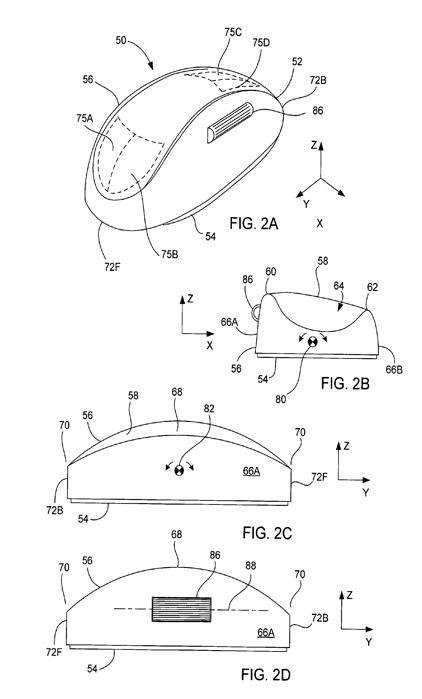An Apple patent (number 7,808,479) for an ambidextrous mouse has appeared at the US Patent & Trademark Office. The ambidextrous mouse is configured for both left and right handed use.
The mouse may include right handed buttons on the front side of the mouse and left handed buttons on the back side of the mouse. The user may change the handedness of the mouse by rotating the mouse about a vertical axis of the mouse such that the left hand can use the left hand buttons and the right hand can use the right hand buttons.
The mouse may include a handedness selection system for configuring the mouse for right handed or left handed use even though the mouse has the capability for both right and left hands. The inventors are Steve Hotelling and Brian Huppi.
Here’s Apple’s background and summary of the invention: “Most computer systems, as for example general purpose computers such as portable computers and desktop computers, receive input from a user via an input device such as a mouse. As is generally well known, the mouse allows a user to move an input pointer (e.g., cursor) and to make selections with respect to a graphical user interface (GUI) on a display screen. The mouse typically includes a trackball or optical sensor (located at the bottom side of the mouse) for translating the motion of the users hand into signals that the computer system can use. For example, by positioning the mouse on a desktop and moving it thereon, the user can move an input pointer or cursor in similar directions within the GUI.
“The mouse also conventionally includes one or more buttons, which are located on the top side of the mouse. These one or more buttons, when selected, can initiate a GUI action such as menu or object selections. The one or more buttons are typically provided by on or more button caps that move relative to the housing (e.g., through an opening in the housing). Mice may also include a scroll wheel to give the user scrolling functionality. The scroll wheel saves time and steps, and allows a user to move through documents by physically rolling the wheel forward or backward-instead of clicking on the scroll bar displayed on the GUI.
“In the past, scrolling was implemented by selecting the scroll bar with the mouse, and moving the scroll bar on the GUI by moving the mouse up or down. Furthermore, many popular mice offer an asymmetric shape that fits the asymmetric shape of the hand. Unfortunately, an asymmetric mouse is handed, i.e., it can only be used by a right or left hand. Although mice designs such as those described above work well, there are continuing efforts to improve their form, feel and functionality.
“The invention relates, in one embodiment, to an ambidextrous mouse configured for left and right handed use. The handedness of the mouse is changed by rotating the mouse about a vertical axis of the mouse by 180 degrees.
“The invention relates, in another embodiment, to a touch sensitive mouse comprising a touch sensitive surface that senses a user’s touch when the user grabs the mouse.
“The invention relates, in another embodiment, to a computing system. The computing system includes a computer. The computing system also includes a mouse operatively coupled to the computer. The mouse includes a position sensing device and a touch sensing device. The position sensing device is configured to generate tracking signals when the mouse is moved relative to a surface. The touch sensing device is configured to generate hand signals when a hand is placed over the mouse.
“The invention relates, in another embodiment, to a method for operating a mouse having one or more buttons. The method includes determining if a user is touching the mouse. The method also includes determining the user based on the user’s touch. The method additionally includes configuring the mouse based on the user.
“The invention relates, in another embodiment, to a user determination method for a mouse. The method includes providing baseline hand signals. The method also includes generating a current hand signal when a user grabs the mouse. The method further includes comparing the current hand signal to at least one baseline hand signal. The method additionally includes determining a characteristic of the user based on the current and baseline hand signals.
“The invention relates, in another embodiment, to a method for operating a mouse. The method includes determining if a user is touching the mouse. The method also includes determining the handedness of the user based on the user’s touch. The method further includes configuring the motion axes of the mouse based on the handedness of the user. The method additionally includes generating position signals based on mouse movement and the motion axes. Moreover, the method includes sending the position signals to a host. The method also includes forming previous and current hand images and calculating the difference between the previous and current hand images. Thereafter, the method further includes generating control signals based on the difference between the previous and current hand images and sending the control signal to the host.”



